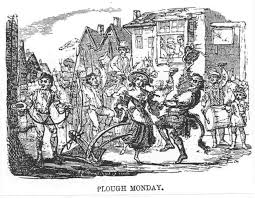Plough Monday
 Plough Monday: First Monday after Epiphany
Plough Monday: First Monday after Epiphany Like St Distaff's Day, Plough Monday in England of old represented a return to work after the Christmas holidays. Before the Protestant Reformation, ploughmen (or, plough bullockers) kept lights burning in front of certain images in the church, and there was also a procession, with the men gathering money for the support of these plough-lights as they were called. A plough light was a lamp in the church that was never allowed to go out .
After the Reformation, the procession continued, with the men collecting money to spend on grog instead. A plough known as the Fool Plough was decorated with ribbons among other things, and dragged from house to house by 30 or 40 men dressed in clean smock-frocks, hats and shirts (outside their coats) decorated with ribbons and wheat. The Fool Plough was preceded by one ploughman in front dressed – over-dressed, in fact, and wearing a bullock’s tail – as an old woman known as Bessy, and carrying the money box. There was also a fool, or jester, in fantastic costume. In some parts of the country, morris dancers entertained the throng, and in the corn growing areas of eastern England, Plough Plays were versions of mumming plays. Sometimes there was a reproduction of an ancient sword dance that might have Scandinavian, Germanic or Roman origins. One of the ‘mummers’ wore a fox-skin hood, the meaning of which has been lost in the passing centuries ...
This is just a snippet of today's stories. Read all about today in folklore, historical oddities, inspiration and alternatives at the Wilson's Almanac Book of Days, every day. Click today's date when you're there.
A note about the dating of items in Wilson’s Almanac
Categories: british-folklore, calendar-customs, folklore







0 Comments:
Post a Comment
<< Home